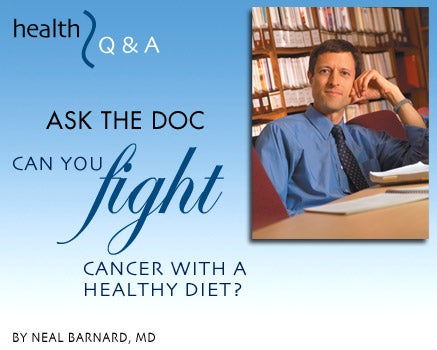Can you Fight Cancer with a Healthy Diet?

Q: I know that diet plays a role in the risk of developing cancer. But what about people who already have been diagnosed: What willor won’tdiet changes do for them?
A: That’s a great question and a very important one since as many as one in three people in North America will get cancer at some point.
As far back as the early 1960s, researchers observed that women in Japan were much less likely than Americans to develop breast cancer and, even if they got it, were less likely to die from it. The traditional Japanese diet, very low in fat and rich in grains and vegetables, seemed to offer a possible explanation.
Then in 1985, researchers at the State University of New York at Buffalo analyzed the eating habits of women who had been diagnosed with advanced breast cancer. They found that women with the lowest fat intake lived longer. The risk of dying from cancer increased by 40 percent for every 1,000 grams of fat the women had consumed per month.
Other studies found much the same thing. And earlier this year, the Women’s Intervention Nutrition Study, a major trial funded by the National Cancer Institute, reported results from 2,500 postmenopausal breast cancer patients. Women who hadafter diagnosisbegun a low-fat diet (33 grams of fat daily) and maintained it for several years had a lower risk of the cancer coming back and better survival rates than those who didnt change their diets (and averaged 51 grams of fat daily).
The benefit of a low-fat diet is apparently due to its effect on estrogens, the female sex hormones that stimulate the growth of breast tissue at puberty and can accelerate cancer cell growth later in life. When a woman cuts her fat intake, estrogen levels in the bloodstream fall (why isn’t clear), although there is still enough estrogen to maintain good health. That means there is less stimulus for cancer cells to grow.
Adding fiber also helps the body eliminate excess hormones. Here’s how: The liver filters excess estrogens out of the bloodstream and sends them into the intestinal tract where fiber absorbs them and carries them away. Eating 30 grams of fiber or more daily helps flush out the excess estrogens. But women who eat a low-fiber diet will actually reabsorb these risky waste estrogens.
Low-fat, high-fiber diets also help with weight control. That’s important because women who are close to their ideal weight have much better cancer survival rates than women who are very overweight. Diets rich in vegetables and fruits may also strengthen the white blood cells that seek out and attack cancer cells.
Much the same results have emerged in men who have prostate cancer. In 2002, Dean Ornish, MDwho by then had already demonstrated the life-saving benefits of a very low-fat vegetarian diet in heart patientstested a low-fat vegan diet in prostate cancer patients. For three months, one group of 42 men ate normally, and, on average, their prostate-specific antigen (PSA) levels rose, a sign that the disease was progressing. (PSA levels are used to track the growth of prostate cancer.) But the PSA levels in a second group of 42 men, who all ate a vegan diet, actually fell slightly, a sign that the cancer was not advancing; none of these men required further treatment.
Using diet to help fight other forms of cancer hasn’t been well studied. However, it is likely that the diets that can help with breast or prostate cancers may also help alleviate cancers in other hormoneresponsive organs (such as uterine, ovarian or testicular cancer). And high-fiber diets might help cancers in the digestive tract.
So what does a cancer-fighting diet look like? It appears to avoid animal products, keep oils very low (minimizing fats), favor whole grains over refined grain products (maximizing fiber) and include plenty of vegetables and fruits.
A few cautions: First, diet changes should be made in addition to medical diagnosis and treatment, not instead of them, and should always be done in close consultation with the physician involved.
Second, remember that 10 years or more can elapse between the time cancer cells first arise and the point at which a tumor becomes large enough to be diagnosed. So it’s a good idea to follow a cancer-fighting diet before cancer is ever an issue. The same good eating habits that help combat cancer can also help prevent it.
Fiber Kings
The following easy-to-use foods are not only flavorful, they’re powerful sources of fiberan important element of a cancer-fighting diet.
FOOD: Navy Beans
SERVING: 1 cup
FIBER (GRAMS): 19.1
FOOD: Kidney beans, canned
SERVING: 1 cup
FIBER (GRAMS): 16.4
FOOD: Split peas, cooked
SERVING: 1 cup
FIBER (GRAMS): 16.3
FOOD: Lentils, cooked
SERVING: 1 cup
FIBER (GRAMS): 15.6
FOOD: Black beans, cooked
SERVING: 1 cup
FIBER (GRAMS): 15.0
FOOD: Wheat flour, whole grain
SERVING: 1 cup
FIBER (GRAMS): 14.6
FOOD: Dates
SERVING: 1 cup
FIBER (GRAMS): 14.2
FOOD: Refried beans, canned
SERVING: 1 cup
FIBER (GRAMS): 13.4
FOOD: Chickpeas, cooked
SERVING: 1 cup
FIBER (GRAMS): 12.5
FOOD: Tomato paste, canned
SERVING: 1 cup
FIBER (GRAMS): 11.8
FOOD: Raspberries, frozen
SERVING: 1 cup
FIBER (GRAMS): 11.0
FOOD: Cornmeal
SERVING: 1 cup
FIBER (GRAMS): 10.2
FOOD: Artichokes, cooked
SERVING: 1 cup
FIBER (GRAMS): 9.1
FOOD: Blackberries, fresh
SERVING: 1 cup
FIBER (GRAMS): 7.6
FOOD: Spinach, frozen
SERVING: 1 cup
FIBER (GRAMS): 7.0